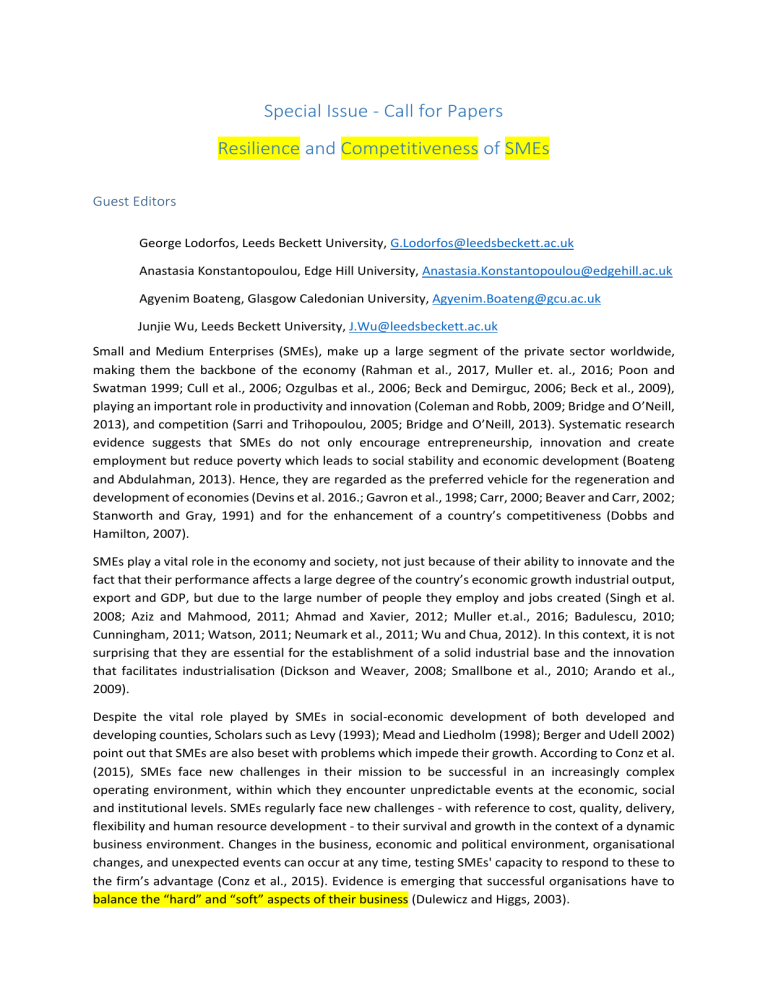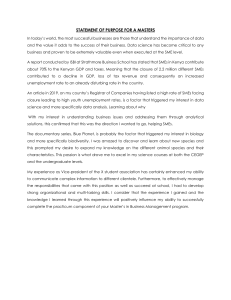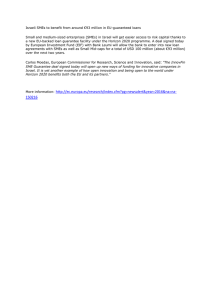
Special Issue - Call for Papers Resilience and Competitiveness of SMEs Guest Editors George Lodorfos, Leeds Beckett University, G.Lodorfos@leedsbeckett.ac.uk Anastasia Konstantopoulou, Edge Hill University, Anastasia.Konstantopoulou@edgehill.ac.uk Agyenim Boateng, Glasgow Caledonian University, Agyenim.Boateng@gcu.ac.uk Junjie Wu, Leeds Beckett University, J.Wu@leedsbeckett.ac.uk Small and Medium Enterprises (SMEs), make up a large segment of the private sector worldwide, making them the backbone of the economy (Rahman et al., 2017, Muller et. al., 2016; Poon and Swatman 1999; Cull et al., 2006; Ozgulbas et al., 2006; Beck and Demirguc, 2006; Beck et al., 2009), playing an important role in productivity and innovation (Coleman and Robb, 2009; Bridge and O’Neill, 2013), and competition (Sarri and Trihopoulou, 2005; Bridge and O’Neill, 2013). Systematic research evidence suggests that SMEs do not only encourage entrepreneurship, innovation and create employment but reduce poverty which leads to social stability and economic development (Boateng and Abdulahman, 2013). Hence, they are regarded as the preferred vehicle for the regeneration and development of economies (Devins et al. 2016.; Gavron et al., 1998; Carr, 2000; Beaver and Carr, 2002; Stanworth and Gray, 1991) and for the enhancement of a country’s competitiveness (Dobbs and Hamilton, 2007). SMEs play a vital role in the economy and society, not just because of their ability to innovate and the fact that their performance affects a large degree of the country’s economic growth industrial output, export and GDP, but due to the large number of people they employ and jobs created (Singh et al. 2008; Aziz and Mahmood, 2011; Ahmad and Xavier, 2012; Muller et.al., 2016; Badulescu, 2010; Cunningham, 2011; Watson, 2011; Neumark et al., 2011; Wu and Chua, 2012). In this context, it is not surprising that they are essential for the establishment of a solid industrial base and the innovation that facilitates industrialisation (Dickson and Weaver, 2008; Smallbone et al., 2010; Arando et al., 2009). Despite the vital role played by SMEs in social-economic development of both developed and developing counties, Scholars such as Levy (1993); Mead and Liedholm (1998); Berger and Udell 2002) point out that SMEs are also beset with problems which impede their growth. According to Conz et al. (2015), SMEs face new challenges in their mission to be successful in an increasingly complex operating environment, within which they encounter unpredictable events at the economic, social and institutional levels. SMEs regularly face new challenges - with reference to cost, quality, delivery, flexibility and human resource development - to their survival and growth in the context of a dynamic business environment. Changes in the business, economic and political environment, organisational changes, and unexpected events can occur at any time, testing SMEs' capacity to respond to these to the firm’s advantage (Conz et al., 2015). Evidence is emerging that successful organisations have to balance the “hard” and “soft” aspects of their business (Dulewicz and Higgs, 2003). Therefore, there is a growing mandate to create SMEs which have the capacity to survive, adapt and even grow in the face of turbulent change and an unpredictable environment. In order to build sustainable SMEs, resilience as a concept becomes critical (Ates and Bititci 2011; Sheffi 2005, 2006). There are a number of important drivers and determinants in the evolution towards resilient, sustainable enterprises, ranging from SMEs’ organisational behaviour and characteristics (Moore and Manring, 2009) to factors such as changing market trends, changing technologies and emerging new management and organisational techniques (Gunasekaran et al., 2011) . Mafabi et al. (2015) define organisational resilience as the organisation’s ability to cope with change through continuous renewal of business operations. Resilience of SMEs, according to Egbu et al. (2005), requires knowledge retention through a flexible workforce, strategic managerial thinking, top management support and technology. They need to be proactive in knowledge-sharing arrangements to recognise that knowledge has value and the value added is derived from knowledge exchange (Egbu et al., 2005). Some studies have, with limited empirical support, revealed that a creative environment can be associated with organisational resilience as mediated by innovation. Successful innovation diffusion can lead to resilience behaviours, such as adaptation, competitiveness and value (Mafabi et al., 2015). Studies on the resilience of SMEs have increased in recent years, but according to Conz et al. (2015), several gaps in understanding remain, especially in terms of the perspective that considers which determinants influence the resilience of organisations. Against this background, the International Journal of Organizational Analysis announces a special issue that aims to bring together leading research on the determinants of resilience and competitiveness of SMEs, focussing on both internal and external factors that may affect SMEs' sustainability and growth. Objectives and Scope of the Special Issue: The purpose of this special issue is to gather empirical, meta-analytical, review, and theoretical research which provides a significant contribution to the understanding of the determinants of resilience and competitiveness in SMEs. We encourage the submission of research from a range of different methodological approaches on SMEs’ competitiveness and resilience, involving internal and external factors, different levels of organisational analysis or cross-disciplinary perspectives. In this vein, we invite contributions from the organisational analysis perspective, and encourage submissions that address resilience, or competiveness of SMEs in various contexts and settings. The special issue seeks both theoretical submissions that serve as a stepping-stone for empirical work, and theoretically-informed empirical work following the normal standards of IJOA. Empirical insights might be derived from a number of methodologies, including but not limited to survey research, case studies, action research, event studies, interviews, or experiments. We welcome contributions in topic areas that include, but are not limited to: Shaping and conceptualising the concept of resilience in SMEs; Assessing the determinants of resilience in SMEs; Linking resilience to other concepts, such as sustainability, agility and competitiveness; Studies into the effects of specific disruptions to SMEs’ environment, e.g. economic crises or the recent ‘Brexit’, and/or particular business strategies. Studying SMEs' resilience and competitiveness in specific contexts, for example, in developing countries, or among family-owned businesses; Cross-disciplinary research, e.g. in relation to employer branding, organisational behaviour, access to finance, knowledge management, etc. Submissions Submissions to IJOA are made using ScholarOne Manuscripts, the online submission and peer review system. Initial submissions for the special issue must be received between DATE 8/1/2018 and DATE 26/2/2018. Authors should designate their manuscript for this Special Issue (select “Special Issue” as the manuscript type when submitting.) Submissions should be accompanied by an assurance of originality and exclusivity and should adhere to the manuscript guidelines for authors that can be found on the journal’s website. If you have questions or suggestions regarding manuscripts, please direct them to the lead guest editor, Professor George Lodorfos at g.lodorfos@leedsbeckett.ac.uk. All submissions will be subject to a rigorous double-blind peer review process, with one or more of the guest editors acting as action editor. References Ahmad, Z. S. and Xavier, R. S. (2012), ‘Entrepreneurial environments and growth: evidence from Malaysia GEM data’, Journal of Chinese Entrepreneurship, Vol. 4 No.1, pp.50 – 269. Gunasekaran, A., Rai, B. K., and Griffin, M. (2011) Resilience and competitiveness of small and medium size enterprises: an empirical research, International Journal of Production Research, 49:18, 54895509. Arando, S., Peña, I., and Verheul, I. (2009). ‘Market entry of firms with different legal forms: an empirical test of the influence of institutional factors’, International Entrepreneurship and Management Journal, Vol.5 No.1 pp77-95. Ates, A. and Bititci, U. (2011). Change process: a key enabler for building resilient SMEs, International Journal of Production Research, 49:18, 5601-5618, DOI: 10.1080/00207543.2011.563825 Aziz, A. S. and Mahmood, R. (2011). ‘The relationship between business model and performance of manufacturing small and medium enterprises in Malaysia’, African Journal of Business Management, Vol. 5, No. 22, pp.8918–8932. Badulescu, D. (2010). SMEs financing: the extent of need and response of different credit structures. Theoretical and Applied Economics, Vol. 7(548), pp. 25-36. Beaver, G. and Carr, P. (2002). ‘The enterprise culture: understanding a misunderstood concept’, Journal of Strategic Change, March–April, Vol. 11, No. 2, pp105–113. Beck, T. and Demirguc-Kunt, A. (2006). Small and medium enterprises: access to finance as a growth constraints. Journal of Banking and Finance, Vol. 30 (11), pp. 2931-2943. Beck, T., Demirguc-Kunt, A. and Peria, M. S. M. (2009). Bank financing for SMEs: evidence across countries and bank-ownership types. European Banking Centre Discussion, No.2009-71. Berger, A.N. and Udell, G.F. (2002). Small Business Credit Availability and Relationship lending: The Impotance of Bank Organisation Structure, The Economic Journal, 112, 32-53. Boateng, A and Abdulrahman, M.D. (2013). Micro Small-sized Enterprises and Bank Credit: Evidence from West Africa, Journal of Emerging Market Finance, 12, 2, 129-150. Bridge, S. and O’Neill, K. (2013). Understanding Enterprise: Entrepreneurship and Small Business. 4th ed. Hampshire: Palgrave Macmillan. Carr, M., Chen, A. and Tate, J. (2000). ‘Globalization and home-based workers’, Feminist Economics, Vol. 6, No. 3, pp123–142. Coleman, S. and Robb, A. (2009). A comparison of new firm financing by gender: evidence from the Kauffman firm survey data. Small Business Economics, Vol. 33(4), pp. 397-411. Conz, E., Denicolai, S., and Zucchella, A. (2017). "The resilience strategies of SMEs in mature clusters", Journal of Enterprising Communities: People and Places in the Global Economy, Vol. 11 Issue: 1, pp.186-210, https://doi.org/10.1108/JEC-02-2015-0015. Cull, R. (2006). Historical financing of small- and medium-size enterprises. Journal of Banking and Finance, 30(11): 3017–3042. Cunningham, L. X. (2011). SMEs as motors of growth: A review of China’s SMEs development in thirty years (1978-2008). Human Systems Management, Vol. 30 (1, 2), pp. 39-54. Devins, D., Lodorfos, G., Kostopoulos, I., Webber, D. (2016). Innovation and Growth in the City Region: Microeconomic Evidence of Asymmetries. International Journal of Innovation Management 20(2):01 Feb 2016 Dickson, P. H. and Weaver, K. M. (2008). ‘The role of the institutional environment in determining firm orientation towards entrepreneurial behaviour’, International Entrepreneurship Management Journal, Vol. 4, No. 4, pp 467–483. Dulewicz, V., and Higgs, M., (2003). “Leadership at the top: the need for emotional intelligence in Organisations”, International Journal of Organisational Analysis, 11(3): 193. Egbu, C. O., Hari, S., and Renukappa, S. H. (2005). Knowledge management for sustainable competiveness in small and medium surveying practices. Structural Survey, 23(1): 7–21. Gavron, R., Cowling, M., Holtham, G., and Westall, A. (1998), The Entrepreneurial Society, Institute for Public Policy Research, London. Klijn, M., and Tomic, W., (2010). A review of creativity within organizations from a psychological perspective. Journal of Management Development 29(4): 322-343 Levy, B. (1993). Obstacles to developing indigenous small and medium enterprises: An empirical assessment, World Bank Economic Review, 7, 1, 65-83. Mafabi, S., Munene, S. M., and Ahiauzu, A. (2015). Creative climate and organisational resilience: the mediating role of innovation. International Journal of Organizational Analysis 23(4):564-587 Mead, D. and Liedholm, C. (1998). The Dynamics of Micro and Small Enterprises in Developing Countries, World Development, 26, 1, 61-74. Moore, S. B. and Manring, S. L., (2009). Strategy development in small and medium sized enterprises for sustainability and increased value creation. Journal of Cleaner Production, 17, 276–282. Muller, P., Devnani, S., Julius, J., Gagliardi, D. and Marzocchi, C. (2016). Annual Report on European SMEs 2015/2016. SME recovery continues. SME Performance Review 2015/2016. European Commission, EASME/COSME/2015/012. Neumark, D., Wall, B. and Zhang, J. (2011). Do small businesses create more jobs? New evidence for the United States from the National Establishment Times Series. The Review of Economics and Statistics, Vol. 93(1), pp. 16-29. Ozgulbas, N., Koyuncugil, A. S. and Yilmaz, F. (2006). Identifying the effect of firm size on financial performance of SMEs. The Business Review, 6(1): 162–167. Poon, S. and Swatman, P. M. C. (1999). An exploratory study of small business Internet commerce issues. Information and Management, 35(1): 9–18. Rahman, M., Uddin, M. and Lodorfos, G. (2017). Barriers to enter in foreign markets: evidence from SMEs in emerging market. International Marketing Review 34(1): 68-86 01 Jan 2017 Salavou, H., Baltas, G. and Lioukas, S. (2004). Organizational innovation in SMEs: the importance of strategic orientation and competitive structure. European Journal of Marketing, 38(9–10): 1091– 1112. Sarri, K. and Trihopoulou, A. (2005). Female entrepreneurs’ personal characteristics and motivation: a review of the Greek situation. Women in Management Review, Vol. 20(1), pp. 24-36. Sheffi, Y. (2005). The resilient enterprise: overcoming vulnerability for competitive advantage. Cambridge, MA: MIT Press. Sheffi, Y. (2006). Resilience reduces risk. Logistics Quarterly, 12 (1), 12–14 Stanworth, J. and Gray, C. (1991). Bolton 20 Years On: The Small Firm in the 1990s, Paul Chapman, London. Singh, R. K., Garg, S. K. and Deshmukh, S. G. (2008). Challenges and strategies for competitiveness of SMEs: a case study in the Indian context. International Journal of Services and Operations Management, 4(2): 181–200. Smallbone, D., Welter, F., Voytovich, A. and Egorov, I. (2010). ‘Government and entrepreneurship in transition economies: the case of small firms in business services in Ukraine’, Service Industries Journal, Vol. 30, No. 5, pp 655–670. Watson, J. (2011). Networking: gender differences and the association with firm performance. International Small Business Journal, Vol. 30(5), pp. 536-558. Wu, Z. and Chua, J. H. (2012). Second-order gender effects: The case of U.S. small business borrowing cost. Entrepreneurship Theory and Practice, Vol. 36(3), pp. 443-463.





